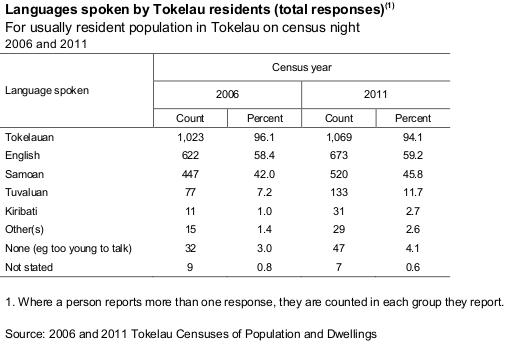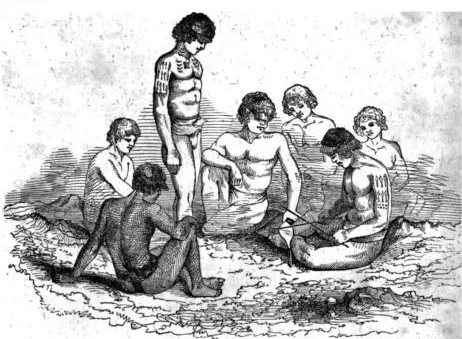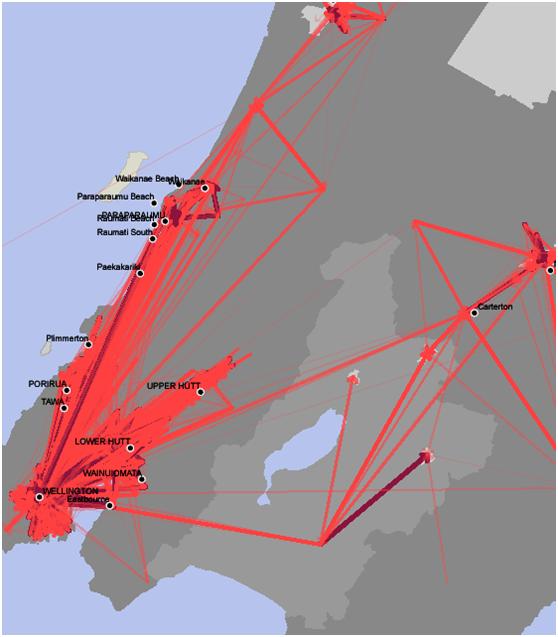|
Languages Of Tokelau
Tokelau has two official languages: Tokelauan and English. Over 90% of the population speaks Tokelauan, and just under 60% speak English. Also, 45.8% of the population speak Samoan, and small percentages of the population speak Tuvaluan and Kiribati. Change over time Since 2006, there has been growth in the proportion of the Tokelau population who can speak languages other than the country's native tongue. In contrast, the proportion of the total population able to speak Tokelauan has dropped, from 96.1% (in 2006) to 94.1% (in 2011). The biggest difference since 2006 in languages spoken is the proportion of the population able to carry out a conversation in Tuvaluan, up from 7.2% (in 2006) to 11.7% (in 2011). Multilingualism In Tokelau, approximately two-thirds (67.6%) of the population were able to speak two or more languages. Also, a large proportion of the population (40.7%) could converse in three or more languages. The most-common number of languages spoken on Atafu and ... [...More Info...] [...Related Items...] OR: [Wikipedia] [Google] [Baidu] |
Tokelau
Tokelau (; ; known previously as the Union Islands, and, until 1976, known officially as the Tokelau Islands) is a dependent territory of New Zealand in the southern Pacific Ocean. It consists of three tropical coral atolls: Atafu, Nukunonu, and Fakaofo. They have a combined land area of . The capital rotates yearly among the three atolls. In addition to these three, Swains Island, which forms part of the same archipelago, is the subject of an ongoing territorial dispute; it is currently administered by the United States as part of American Samoa. Tokelau lies north of the Samoan Islands, east of Tuvalu, south of the Phoenix Islands, southwest of the more distant Line Islands, and northwest of the Cook Islands. Tokelau has a population of approximately 1,500 people; it has the fourth-smallest population of any sovereign state or dependency in the world. As of the 2016 census, around 45% of its residents had been born overseas, mostly in Samoa or New Zealand. The populace has ... [...More Info...] [...Related Items...] OR: [Wikipedia] [Google] [Baidu] |
Tokelauan Language
Tokelauan is a Polynesian language spoken in Tokelau and on Swains Island (or Olohega) in American Samoa. It is closely related to Tuvaluan and is related to Samoan and other Polynesian languages. Tokelauan has a co-official status with English in Tokelau. There are approximately 4,260 speakers of Tokelauan, of whom 2,100 live in New Zealand, 1,400 in Tokelau, and 17 in Swains Island. "Tokelau" means "north-northeast". Loimata Iupati, Tokelau's resident Director of Education, has stated that he is in the process of translating the Bible from English into Tokelauan. While many Tokelau residents are multilingual, Tokelauan was the language of day-to-day affairs in Tokelau until at least the 1990s, and is spoken by 88% of Tokelauan residents. Of the 4600 people who speak the language, 1600 of them live in the three atolls of Tokelau – Atafu, Nukunonu and Fakaofo. Approximately 3000 people in New Zealand speak Tokelauan, and the rest of the known Tokelauan speakers are spread ac ... [...More Info...] [...Related Items...] OR: [Wikipedia] [Google] [Baidu] |
English Language
English is a West Germanic language of the Indo-European language family, with its earliest forms spoken by the inhabitants of early medieval England. It is named after the Angles, one of the ancient Germanic peoples that migrated to the island of Great Britain. Existing on a dialect continuum with Scots, and then closest related to the Low Saxon and Frisian languages, English is genealogically West Germanic. However, its vocabulary is also distinctively influenced by dialects of France (about 29% of Modern English words) and Latin (also about 29%), plus some grammar and a small amount of core vocabulary influenced by Old Norse (a North Germanic language). Speakers of English are called Anglophones. The earliest forms of English, collectively known as Old English, evolved from a group of West Germanic (Ingvaeonic) dialects brought to Great Britain by Anglo-Saxon settlers in the 5th century and further mutated by Norse-speaking Viking settlers starting in the 8th and 9th ... [...More Info...] [...Related Items...] OR: [Wikipedia] [Google] [Baidu] |
Samoan Language
Samoan ( or ; ) is a Polynesian language spoken by Samoans of the Samoan Islands. Administratively, the islands are split between the sovereign country of Samoa and the United States territory of American Samoa. It is an official language, alongside English, in both jurisdictions. It is widely spoken across the Pacific region, heavily so in New Zealand and also in Australia and the United States. Among the Polynesian languages, Samoan is the most widely spoken by number of native speakers. Samoan is spoken by approximately 260,000 people in the archipelago and with many Samoans living in diaspora in a number of countries, the total number of speakers worldwide was estimated at 510,000 in 2015. It is the third-most widely spoken language in New Zealand, where 2.2% of the population, 101,900 people, were able to speak it as of 2018. The language is notable for the phonological differences between formal and informal speech as well as a ceremonial form used in Samoan oratory. Cla ... [...More Info...] [...Related Items...] OR: [Wikipedia] [Google] [Baidu] |
Tuvaluan Language
Tuvaluan (), often called Tuvalu, is a Polynesian language closely related to the Ellicean group spoken in Tuvalu. It is more or less distantly related to all other Polynesian languages, such as Hawaiian, Māori, Tahitian, Samoan, Tokelauan and Tongan, and most closely related to the languages spoken on the Polynesian Outliers in Micronesia and Northern and Central Melanesia. Tuvaluan has borrowed considerably from Samoan, the language of Christian missionaries in the late 19th and early 20th centuries. The population of Tuvalu is approximately 10,645 people (2017 Mini Census) There are estimated to be more than 13,000 Tuvaluan speakers worldwide. In 2015 it was estimated that more than 3,500 Tuvaluans live in New Zealand, with about half that number born in New Zealand and 65 percent of the Tuvaluan community in New Zealand is able to speak Tuvaluan. Name variations Native speakers of Tuvaluan have various names for their language. In the language itself, it is often re ... [...More Info...] [...Related Items...] OR: [Wikipedia] [Google] [Baidu] |
Kiribati Language
Gilbertese or taetae ni Kiribati, also Kiribati (sometimes ''Kiribatese''), is an Austronesian language spoken mainly in Kiribati. It belongs to the Micronesian branch of the Oceanic languages. The word ''Kiribati'', the current name of the islands, is the local adaptation of the previous European name "Gilberts" to Gilbertese phonology. Early European visitors, including Commodore John Byron, whose ships happened on Nikunau in 1765, had named some of the islands the Kingsmill or Kings Mill Islands or for the Northern group ''les îles Mulgrave'' in French but in 1820 they were renamed, in French, ''les îles Gilbert'' by Admiral Adam Johann von Krusenstern, after Captain Thomas Gilbert, who, along with Captain John Marshall, had passed through some of these islands in 1788. Frequenting of the islands by Europeans, Americans and Chinese dates from whaling and oil trading from the 1820s, when no doubt Europeans learnt to speak it, as Gilbertese learnt to speak English and o ... [...More Info...] [...Related Items...] OR: [Wikipedia] [Google] [Baidu] |
Atafu
Atafu, formerly known as the Duke of York Group, is a group of 52 coral islets within Tokelau in the south Pacific Ocean, north of Samoa. With a land area of , it is the smallest of the three islands that constitute Tokelau. It is an atoll and surrounds a central lagoon, which covers some . The atoll lies some south of the equator at 8° 35' South, 172° 30' West. Population According to the 2016 census, 541 people officially live on Atafu (although only 413 were present the night the census was taken). Of those present, 78% belong to the Congregational Church.2016 Final data tables Retrieved 13-07-2017 The main settlement on the atoll is located on Atafu Island in its northwestern corner. The |
Fakaofo
Fakaofo, formerly known as Bowditch Island, is a South Pacific Ocean atoll located in the Tokelau Group. The actual land area is only about 3 km2 (1.1 sq mi), consisting of islets on a coral reef surrounding a central lagoon of some 45 km2. According to the 2006 census 483 people officially live on Fakaofo (however just 370 were present at census night). Of those present 70% belong to the Congregational Church and 22% to the Catholic Church. Geography and government The main settlement on the island is Fale on Fale Islet, towards the western side of the atoll. Located two kilometres to the west of it is the relatively large Fenua Fala Islet, where a second settlement was established in 1960. Other islets in the group include Teafua, Nukumatau, Nukulakia, Fenua Loa, Saumatafanga, Motu Akea, Matangi, Lalo, and Mulifenua. Fakaofo's Council of Elders is made up of citizens over the age of 60. History The island was sighted by the whale ship ''General Jackson' ... [...More Info...] [...Related Items...] OR: [Wikipedia] [Google] [Baidu] |
Nukunonu
Nukunonu is the largest atoll within Tokelau, a dependency of New Zealand, in the south Pacific Ocean. It comprises 30 islets surrounding a central lagoon, with about of land area and a lagoon surface area of . Motuhaga is the only islet that has inhabitants. It has an estimated population of 448. History The first European vessel known to have come upon Nukunonu was the Royal Navy ship , in 1791, whose captain, Edward Edwards, named Duke of Clarence Island in honor of Prince William, Duke of Clarence and St Andrews (1765-1837), the third son of King George III and later king himself, as William IV. At the time, the ''Pandora'' was searching for mutineers from . During the early 19th century, Nukunonu's inhabitants were converted to Roman Catholicism by Samoan missionaries. Between 1856 and 1979, the United States claimed that it held sovereignty over the island and the other Tokelauan atolls. In 1979, the U.S. conceded that Tokelau was under New Zealand sovereignty, an ... [...More Info...] [...Related Items...] OR: [Wikipedia] [Google] [Baidu] |
Heritage Language
A heritage language is a minority language (either immigrant or indigenous) learned by its speakers at home as children, and difficult to be fully developed because of insufficient input from the social environment. The speakers grow up with a different dominant language in which they become more competent. Polinsky and Kagan label it as a continuum (taken from Valdés definition of heritage language) that ranges from fluent speakers to barely-speaking individuals of the home language. In some countries or cultures which determine a person's mother tongue by the ethnic group they belong to, a heritage language would be linked to the native language. The term can also refer to the language of a person's family or community that the person does not speak or understand, but identifies with culturally. Definitions and use Heritage language is a language which is predominantly spoken by "nonsocietal" groups and linguistic minorities. In various fields, such as foreign language educ ... [...More Info...] [...Related Items...] OR: [Wikipedia] [Google] [Baidu] |
Statistics New Zealand
Statistics New Zealand ( mi, Tatauranga Aotearoa), branded as Stats NZ, is the public service department of New Zealand charged with the collection of statistics related to the economy, population and society of New Zealand. To this end, Stats NZ produces censuses and surveys. Organisation Statistics New Zealand employs people with a variety of skills, including statisticians, mathematicians, computer science specialists, accountants, economists, demographers, sociologists, geographers, social psychologists, and marketers. There are seven organisational subgroups each managed by a Deputy Government Statistician: * Macro-economic and Environment Statistics studies prices, national accounts, develops macro-economic statistics, does government and international accounts, and ANZSIC 06 implementation (facilitating changeover to new classification code developed jointly with Australian statistics officials.) * Social and Population Statistics studies population, social conditions, ... [...More Info...] [...Related Items...] OR: [Wikipedia] [Google] [Baidu] |






